During I-STEM Camp’s NCSA Day, UHS Students Experience Data Visualization, Super Computers, and NCSA’s Research
October 17, 2017
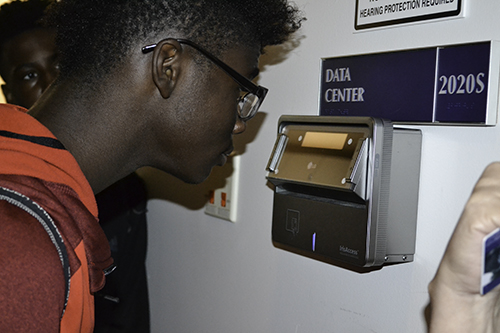
A UHS student tries to bypass the retinal scan necessary to get into the room that houses the Blue Waters supercomputer (spoiler: it didn't work)
Where’s the Popcorn? That was all that was missing when 27 Urbana High School (UHS) student athletes sporting 3D glasses lounged in the cushy, theater-quality seats of NCSA’s viewing room to preview some of the Advanced Visualization Laboratory’s (AVL) high-resolution, cinematic-quality, 3D data visualizations. They were at the National Center for Supercomputing Applications for NCSA Day, the final day of the first-ever, I-STEM Summer Camp: A Multidisciplinary Program. During the Friday, August 18th visit, students also toured the National Petascale Computing Facility and met the Blue Waters Super Computer up close, and also discovered more about what NCSA does while attending a panel discussion hosted by several NCSA researchers and programmers.
NCSA Managing editor, Barbara Jewett, and Education and Outreach Coordinator, Olena Kindratenko, welcomed the student-athletes to the NCSA. With regards to why she and her NCSA colleagues participated in the camp, Jewett gushed: “We love having students here. And we love sharing what we do.”

NCSA Managing Editor, Barbara Jewett (left), and Education and Outreach Coordinator, Olena Kindratenko
During the AVL presentation, students experienced several documentaries that, with the help of Blue Waters, used huge data sets, such as those obtained through the Hubble Telescope, to produce visualizations of the data. Some of the documentaries were even narrated by Hollywood celebrities Leonardo DiCapprio and Benedict Cumberbatch. Plus, students saw a documentary called Seeing the Beginning of Time that explored “hundreds of millions of years of galactic evolution.”
According to Barbara Jewett, a managing editor at NCSA, “Our advanced visualization lab does awesome work. To come here and show things in 3D that are real science, that's pretty awesome. And that just turns people on and interests them. So it's a fun way to show people what science could do.”
Jeff Carpenter, a Multimedia Technology Specialist at the AVL, explains how their visualizations differ from those created in Hollywood. “It's not just ‘We think this’ or ‘We think that’ or that we made this up. What we do differently than they do in Hollywood, our stuff, while we use the same tools, are not necessarily as flashy as the things you're going to see in Guardians of the Galaxy or anything else, like Star Wars or whatever. That's an artistic thing. It may be made to look like real science. But we're using the actual data. That's our basis.”

The panel of NSCA scientists (left to right): Eliu Huerta Escudero, a Physics and Astronomy Research Scientist in the Relativity Group; Dan Lapine from the Scientific Computing Services Group; Adam Slagell of NCSA’s Cybersecurity Group; and AVL research programmer Kalina Borkiewicz
Next students attended a panel featuring several NCSA scientists who shared more about some of the research going on there: AVL research programmer Kalina Borkiewicz; Eliu Huerta, a Physics and Astronomy Research Scientist in the Relativity Group; Dan Lapine from the Scientific Computing Services Group; and Adam Slagell of NCSA’s Cybersecurity Group, After lunch, students toured the National Petascale Computing Facility to experienc Blue Waters, one of the most powerful supercomputers in the world.
Jewitt indicates that one of the benefits of taking young people to see the facility’s super computers is to expose them to possible careers: to “show them what you can do in the field of computer engineering, computer programming, software engineering, there's even a thing called storage engineering and network engineering to help people do the internet. To save their data.
So there's so many ways you can be involved in science, engineering, computer science, without actually being a hands-on scientist studying a deep scientific subject.”
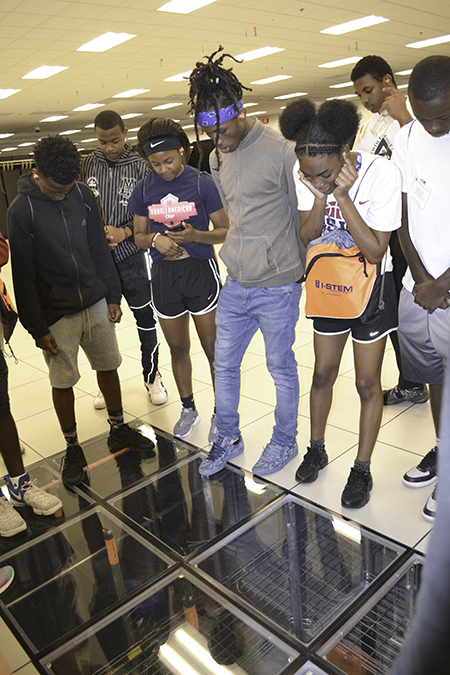
I-STEM campers get a chance to see the access panels beneath the supercomputer room.
Jewett adds that events like I-STEM’s camp are important: “Because you never know what is going to change someone’s life. And it is very important that we encourage young people to explore careers and the other opportunities that are available to them in the areas of math and science. And by exposing them to what is available on campus, we can stimulate their interest.”
As an example, Jewitt shares an anecdote about her daughter, a chemistry Ph.D. student. “She got her interest in chemistry from freshman chemistry the very first day,” Jewett explains, “when the instructor poured two solutions together, and they turned pink! Pink is her favorite color and she was very interested in exploring what you could do with things that made pink. And now she's very involved in chemistry education.”
“You just never know,” she continues. “It could be they go on to be a scientist or be an engineer, or perhaps join an organization like NCSA and help promote science through visualization, through data management, through communicating science either as a science journalist or as a visualization programmer. There are so many opportunities and things you can do with science.”
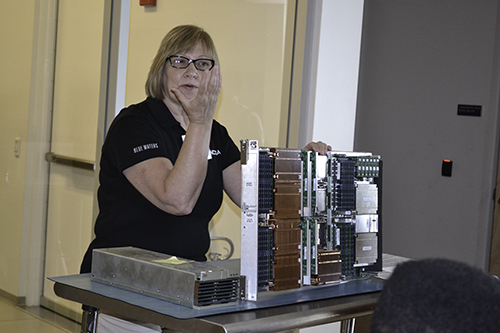
NSCA Managing editor Barbara Jewett presents to the campers during their tour.
“Plus, let’s face it,” she continues, “science affects our daily lives. All the food we eat; all the products we use; the air we breathe; the science that grows things. So science is in everything. So just the exposure to it and getting people involved in science is really important.”
The AVL’s Jeff Carpenter echoes Jewitt’s sentiment about communicating the importance of NCSA’s scientific research: “We're showing the things that are in the science. And by being able to communicate the science to people, hopefully they'll have an understanding of what goes into that research. That it is real, that there is value to it, and we should try to understand not only the universe, but our place in the universe and how we can maybe have an impact on how it has an impact on us.”
Carpenter adds that it's important not only for kids, but to show a larger audience why the science done at NCSA is important, and how what they do makes a difference. He stresses the importance of having an educated populous:
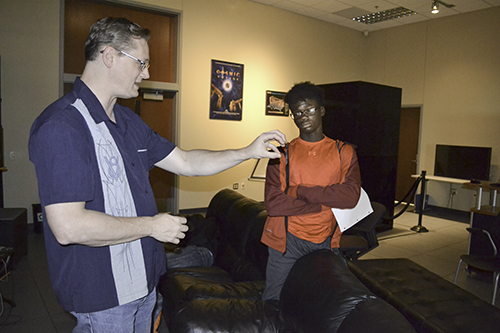
AVL Multimedia Technology Specialist, Jeff Carpenter, talks to a camper about NCSA's scientific research.
“If people understand science, they're not going to be taken in by pseudo-science, fake science, or bad information. I think that's where it's important, if you can show people that it's real, if you can get them to understand, this is data; it's done in a scientific way.”
Carpenter adds that he really believes in the STEAM aspect of STEM. (In STEAM, Art is emphasized, along with Science, Technology, Engineering, and Mathematics.) He says that at the AVL they call themselves a Renaissance team, in the same way that Leonardo Da Vinci was considered to be a Renaissance man, stressing the importance during the Renaissance of both technology and art. He claims that without the vehicle of art, “You couldn't communicate the technology,” but also stresses the importance of the technology: “If it's just art, there's not function behind that. Both are increased and are better when combined together.”
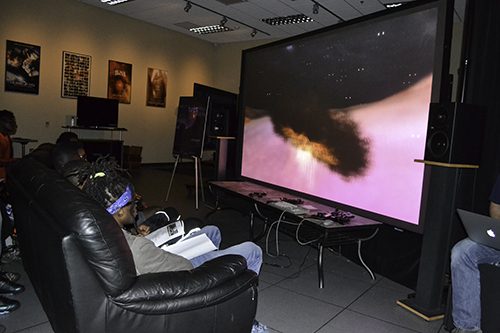
UHS students enjoying one of the AVL's 3D presentations.
Carpenter also believes that effectively portraying the scientific data requires using both creativity and intuition: “Pure science without looking at it from an artistic or creative side is less than when together, because you can use your intuition. Creativity is not just drawing and painting visuals. Creativity is also the spark of imagination where we can look at the data and we can understand it in a different way through our imagination, through our creativity. ‘Well, what is happening? Why is that happening?’ It's that intuition, that spark of bringing it to the data itself. So then that's where the art comes from and the benefits.”
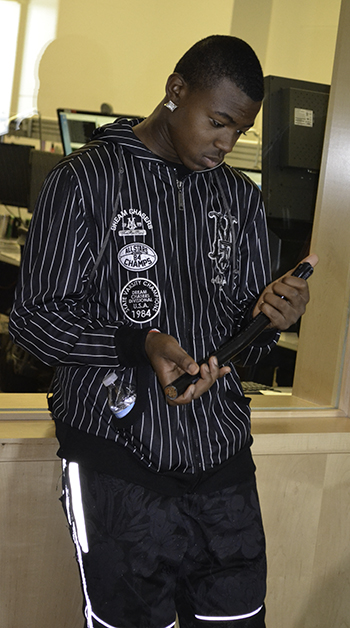
A UHS student-athlete inspects the sheer width of a sample Blue Waters cable
Author/Photographer: Elizabeth Innes, Communications Specialist, I-STEM Education Initiative
More: 8-12 Outreach, Blue Waters, I-STEM Initiatives, STEM Pipeline, Summer Camp, Underserved Students/Minorities in STEM, Urbana High School, 2017
For additional articles about I-STEM's 2017 Summer Camp, see:
- I-STEM Multidisciplinary Summer Program Exposes UHS Athletes to Different STEM Departments/Units
- MCBees Use “Whodunit?” to Pique UHS Students’ Interest in Science During I-STEM Summer Camp
- MNTL Day Exposes UHS Students to Nanotechnology Research During I-STEM’s Summer Multidisciplinary Camp
- Akono and Company Teach UHS Students About Civil Engineering and Strength of Materials During I-STEM’s Multidisciplinary Summer Camp
- ECE Day at I-STEM’s Multidisciplinary Summer Camp: Soldering, Circuits, and Software
- Math Day at I-STEM’s Multidisciplinary Summer Camp Adds Up to Fun
- During I-STEM Summer Camp, Urbana High School Students’ Understanding of Aerospace Engineering Soars
- UHS Students Explore Computer Science, Coding, During I-STEM Camp’s CS Day
- At I-STEM's Multidisciplinary Summer Camp, UHS Students Have Fun with Chemistry—Everything From Soap Making To Glow Sticks to Ice Cream
- UHS Students Gear Up for Mechanical Science and Engineering During I-STEM Summer Camp
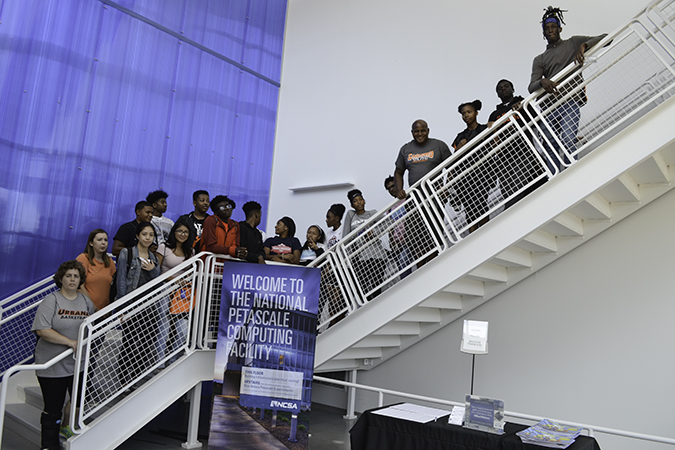
UHS students during a tour of the National Petascale Computing Facility.













.jpg)
















